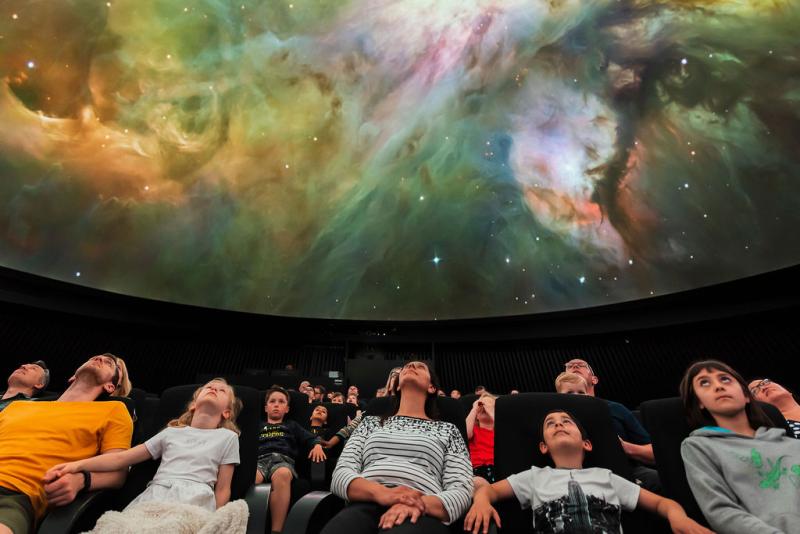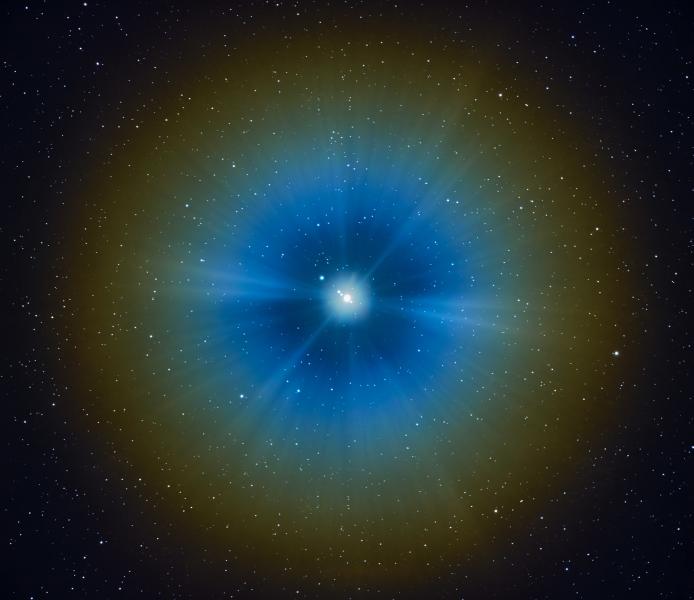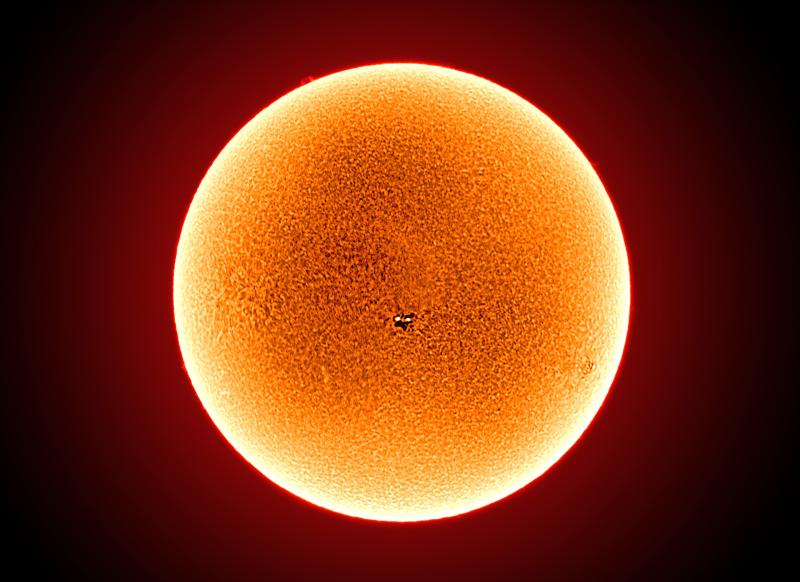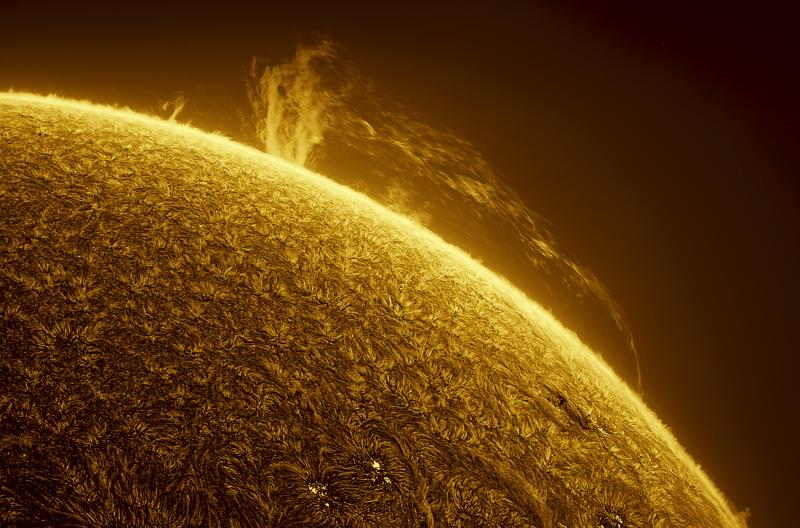
Discover what to see in December's night sky, including the constellation of Gemini, the show-stopping Geminid meteor shower, and some festive stargazing
Written with Lexi Dragovic, Astronomy Education Assistant
Top three things to see in the night sky in December 2023
- Throughout the month - find Castor and Pollux, the twins of Gemini.
- 14 December - the Geminid meteor shower peaks.
- Throughout the month - spot Venus in the early mornings.
(Details given are for London and may vary for other parts of the UK)
Look Up! Podcast
Subscribe and listen to the Royal Observatory Greenwich's podcast Look Up! As well as taking you through what to see in the night sky each month, Royal Observatory astronomers pick two space news stories to talk about. In this month's podcast, available below, we talk about the shrinking of Jupiter's Great Red Spot and storms throughout the Solar System, as well as the discovery of infrared aurorae on Uranus.
At the start of December, join the conversation on X (formerly Twitter) (@ROGAstronomers).
Our podcast is available on iTunes and SoundCloud.
Winter solstice: the days will be getting longer again!

The winter solstice for the Northern Hemisphere, which is the exact point when the Northern Hemisphere is orientated away from the Sun, will be at 3:27am GMT on 22 December. At this moment the Sun will be directly above the Tropic of Capricorn, in the Southern Hemisphere. You won’t notice anything special happening at this time, but this will be our shortest day of the year, with only 7 hours, 49 minutes and 42 seconds of daylight. From this point onwards each day will be getting longer, with 7 hours and 54 minutes of daylight by the end of December. So an end to dark evenings is in sight!
Learn more about the winter solstice
Spot the twins - Castor and Pollux
One constellation high in the sky at this time of year is Gemini. This constellation is associated with Castor and Pollux, who were twin brothers in Greek and Roman mythology. In the stories they were twins but only half brothers, with Castor having the king of Sparta as his father, but Pollux being a son of Zeus. The brightest stars in the constellation are named after the twins, and these are easily visible even from light-polluted areas.
Gemini is visible all night long in December and January, and you can find it by drawing a line through Rigel and Betelgeuse in Orion. This will lead you to the star Castor, and Pollux will be just to the left, around 4 degrees away. If you hold up your little finger, at arm's length, and then close one eye, the amount of sky covered by the width of your finger is about one degree. You could use this to help you measure between stars!
Geminid meteor shower
Mid-December marks the peak of the Geminid meteor shower, a showstopper event where streaks of shooting stars illuminate the darkness. Although the Geminids are active from 19 November to 24 December, this fan-favourite meteor shower peaks on 14 December, when astronomers are expecting to see up to 120 meteors per hour.
The Geminids never fail to captivate observers, and this year will be no different. As the Moon is below the horizon for the entire night of 14 December, stargazers will be graced with dark night skies. The meteors can appear in any part of the sky, but they’ll appear to originate from the constellation of Gemini.
What sets the Geminids apart from other meteor showers is their origin: while most meteor showers originate from comets, Geminids are leftover bits and pieces of the asteroid known as 3200 Phaethon. Unlike comets, asteroids don’t develop tails when approaching the Sun, and their composition is different. However, scientists are still debating if Phaethon is even an asteroid - although it is built like one, it doesn’t move like one. Its orbit is highly elliptical, like a comet, which is why some scientists debate if Phaethon could be a completely new class of celestial objects: a rock comet.
The Geminids will be followed by the lesser Ursids, active between 17-26 December and peaking on 22–23 December. However, they're not particularly active, and this year at their maximum the Moon is at waxing gibbous stage, so viewing conditions won't be favourable.
Deep sky Christmas treats
If you’re looking for a telescope target this month you could try a specific part of NGC 2264 known as the Christmas Tree Cluster! This is part of a star forming region around 2,330 light years away, located from our perspective in the constellation of Monoceros (the unicorn).
The area known as the Christmas Tree Cluster is an open cluster of young stars, arranged in a triangular shape which looks, to some, like a decorated Christmas tree. The clouds of gas and dust surrounding the stars are ionised by the stars' radiation, making them glow red in long exposure images. Also within NGC 2264 are the Cone Nebula, the Fox Fur Nebula, and the Snowflake Cluster. All of these are named after their supposed shapes. You’ll have to look for yourself to see if you agree!
NGC 2264 was discovered in 1784 by William Herschel. If you want to find it for yourself it will be high in the southern sky around midnight for the whole of December.
Festive stargazing
Now, talking about festive stargazing – if you’ll be looking up at the sky at midnight on 31 December to enjoy some fireworks, and there aren’t clouds blocking your view, you’ll also be able to admire some celestial objects!
Jupiter will be in the west, around 25 degrees above the horizon. You’ll be able to recognise Jupiter because it will be the brightest point of light in that part of the sky, and have a yellow hue. To measure degrees in the night sky you can use your hand, held out at arm's length with the back of your hand facing you. If you stretch out your thumb and little finger, and curl down the rest of your fingers, the distance from your thumb to your little finger is around 25 degrees. So if your thumb is on the horizon, Jupiter should be at an altitude close to your little finger!
You’ll also see the Moon in the southeast, in its Waning Gibbous phase and approximately 85% illuminated.
Directly in the south you’ll then see Orion, along with Sirius, the brightest star in the sky, visible just below this constellation. You can find Sirius by tracing a line through Orion’s belt to the left, towards the horizon. Sirius is so bright it often appears to be changing colour as the light from the star is refracted by our atmosphere. So take a minute between fireworks to appreciate this slightly more subtle celestial celebration!
If for some reason you’re up around 5am on New Year’s Day – maybe you’re getting up early to see the first sunrise of 2024, or maybe you haven’t yet been to bed – see if you can see Venus shining in the east. It will look like a bright, steady point of light, staying in the sky as it lightens even as all the other stars fade. It will disappear around the time the Sun rises (which on 1 January is at 8am, although it will get light before this).
Southern Hemisphere stargazing
For those stargazing in the Southern Hemisphere, you can also admire Jupiter, the Moon, Orion and Sirius on New Year’s Eve (although they will be in your northern sky rather than southern sky). However, you’ll also have the opportunity to compare Sirius to Canopus, the second brightest star in the sky. Canopus is only visible in the Southern Hemisphere.
Canopus is within the constellation of Carina, represented as the keel of a ship, often linked to the ship Argo Navis, used during the legend of the Trojan War by Jason and the Argonauts. The name Canopus is thought to come from the navigator of another mythical ship, the one which was sent to retrieve Helen of Troy during the same mythical conflict.
It’s a fascinating star because from our location here on Earth it’s about half as bright as Sirius, with an apparent magnitude of -0.74, compared to -1.46 for Sirius. However, its absolute magnitude is much, much brighter. If you could observe both stars from the same distance, Sirius would be about 25 times more luminous than the Sun, but Canopus would be an incredible 10,000 times more luminous. The only reason it isn’t dazzling in our night sky is its distance. Sirius is one of the closest stars to the Earth, only 8 light years away, whereas Canopus is 310 light years away.
Moon phases for December 2023
Third Quarter: 5 December (05:49)
New Moon: 12 December (23:32)
First Quarter: 19 December (18:39)
Full Moon: 27 December (00:33)
You may be interested in
Header image: Misty Winter Moon © Rob Mogford, shortlisted in Astronomy Photographer of the Year 2020













